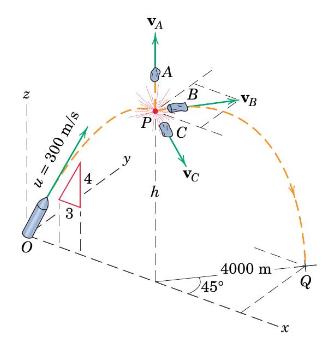A shell with a mass of (20 mathrm{~kg}) is fired from point (O), with a velocity (u=)
Question:
A shell with a mass of \(20 \mathrm{~kg}\) is fired from point \(O\), with a velocity \(u=\) \(300 \mathrm{~m} / \mathrm{s}\) in the vertical \(x-z\) plane at the inclination shown. When it reaches the top of its trajectory at \(P\), it explodes into three fragments \(A, B\), and \(C\). Immediately after the explosion, fragment \(A\) is observed to rise vertically a distance of \(500 \mathrm{~m}\) above \(P\), and fragment \(B\) is seen to have a horizontal velocity \(\mathbf{v}_{B}\) and eventually lands at point \(Q\). When recovered, the masses of the fragments \(A, B\), and \(C\) are found to be 5 , 9 , and \(6 \mathrm{~kg}\), respectively. Calculate the velocity which fragment \(C\) has immediately after the explosion. Neglect atmospheric resistance.
.
Step by Step Answer:






